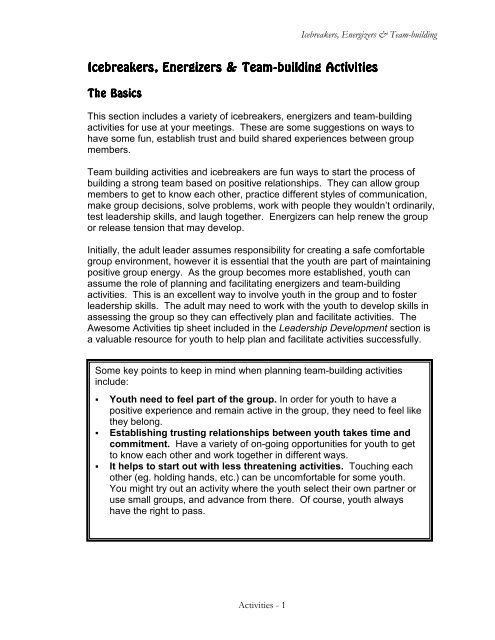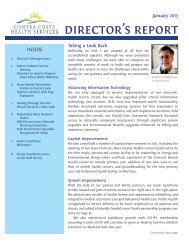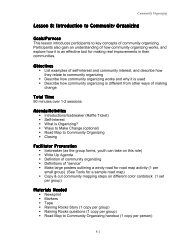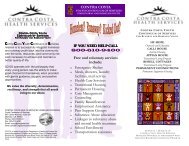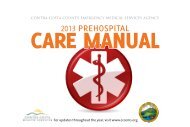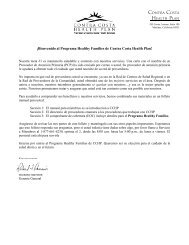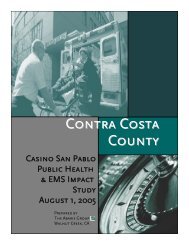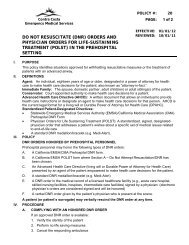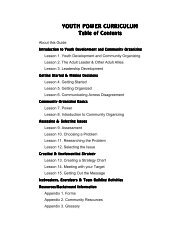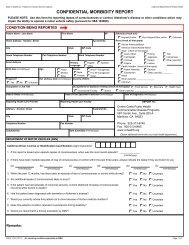Icebreakers, Energizers & Team-building Activities
Icebreakers, Energizers & Team-building Activities
Icebreakers, Energizers & Team-building Activities
You also want an ePaper? Increase the reach of your titles
YUMPU automatically turns print PDFs into web optimized ePapers that Google loves.
<strong>Activities</strong> - 1<br />
<strong>Icebreakers</strong>, <strong>Energizers</strong> & <strong>Team</strong>-<strong>building</strong><br />
<strong>Icebreakers</strong>, <strong>Icebreakers</strong>, <strong>Energizers</strong> <strong>Energizers</strong> & & <strong>Team</strong> <strong>Team</strong>-<strong>building</strong> <strong>Team</strong> <strong>building</strong> <strong>building</strong> <strong>Activities</strong><br />
<strong>Activities</strong><br />
The The The Basics<br />
Basics<br />
This section includes a variety of icebreakers, energizers and team-<strong>building</strong><br />
activities for use at your meetings. These are some suggestions on ways to<br />
have some fun, establish trust and build shared experiences between group<br />
members.<br />
<strong>Team</strong> <strong>building</strong> activities and icebreakers are fun ways to start the process of<br />
<strong>building</strong> a strong team based on positive relationships. They can allow group<br />
members to get to know each other, practice different styles of communication,<br />
make group decisions, solve problems, work with people they wouldn’t ordinarily,<br />
test leadership skills, and laugh together. <strong>Energizers</strong> can help renew the group<br />
or release tension that may develop.<br />
Initially, the adult leader assumes responsibility for creating a safe comfortable<br />
group environment, however it is essential that the youth are part of maintaining<br />
positive group energy. As the group becomes more established, youth can<br />
assume the role of planning and facilitating energizers and team-<strong>building</strong><br />
activities. This is an excellent way to involve youth in the group and to foster<br />
leadership skills. The adult may need to work with the youth to develop skills in<br />
assessing the group so they can effectively plan and facilitate activities. The<br />
Awesome <strong>Activities</strong> tip sheet included in the Leadership Development section is<br />
a valuable resource for youth to help plan and facilitate activities successfully.<br />
Some key points to keep in mind when planning team-<strong>building</strong> activities<br />
include:<br />
Youth need to feel part of the group. In order for youth to have a<br />
positive experience and remain active in the group, they need to feel like<br />
they belong.<br />
Establishing trusting relationships between youth takes time and<br />
commitment. Have a variety of on-going opportunities for youth to get<br />
to know each other and work together in different ways.<br />
It helps to start out with less threatening activities. Touching each<br />
other (eg. holding hands, etc.) can be uncomfortable for some youth.<br />
You might try out an activity where the youth select their own partner or<br />
use small groups, and advance from there. Of course, youth always<br />
have the right to pass.
Additional Additional Resources:<br />
Resources:<br />
TRIBES book (See Community Resources section)<br />
<strong>Activities</strong> - 2<br />
<strong>Icebreakers</strong>, <strong>Energizers</strong> & <strong>Team</strong>-<strong>building</strong><br />
Big Book of <strong>Icebreakers</strong> and <strong>Team</strong> Building (See the Community Resources<br />
Appendix)<br />
Ohio State University Extension: Building Dynamic Groups.<br />
www.ag.ohio-state.edu/~bdg/word_docs/f/C06.doc<br />
www.residentassistant.com
<strong>Icebreakers</strong><br />
<strong>Icebreakers</strong><br />
Group Group Profile<br />
Profile<br />
Materials: newsprint, markers, tape<br />
<strong>Activities</strong> - 3<br />
<strong>Icebreakers</strong>, <strong>Energizers</strong> & <strong>Team</strong>-<strong>building</strong><br />
Preparation: Trace an outline of the human body on newsprint. List the following<br />
topics outside the outline next to the coordinating body part:<br />
Head: dreams or goals we have (for our community)<br />
Ears: things we like to listen to<br />
Eyes: How we like other people to see us<br />
Shoulders: problems young people may have to face.<br />
Hands: things we like to make or do (with our hands)<br />
Stomach: things we like to eat<br />
Heart: things we feel strongly about<br />
Right foot: places we would like to go<br />
Directions:<br />
Post outline of body on the wall. Invite participants to come up to the poster and<br />
write things or pictures to represent each area for them. This is done grafitti<br />
style, free form.<br />
After everyone has had a chance to participate, ask for volunteers to report to the<br />
group on what is listed.<br />
Discuss:<br />
What are common interests? Shared goals? Dreams?<br />
Were there any themes?<br />
What are the things we feel strongly about? How do these relate to our<br />
group’s work?<br />
Honey, Honey, I Love Love You<br />
You<br />
The group forms and sits in a circle. Ask for a volunteer to start the game. That<br />
player approaches one person and says, “Honey, I love you.” That person must<br />
respond by saying, ““Honey, I love you, but I just can’t smile.” If that person<br />
smiles while speaking these words, he/she becomes “it.” If the person does not<br />
smile, the player who started out must approach a new person until he/she<br />
makes someone smile. “It” is not allowed to touch a player as he/she speaks,<br />
but anything else is fair play. This is a funny one, but participants should have<br />
worked together first and have some level of comfort with each other for it to<br />
work!
<strong>Activities</strong> - 4<br />
<strong>Icebreakers</strong>, <strong>Energizers</strong> & <strong>Team</strong>-<strong>building</strong><br />
Incorporation<br />
Incorporation<br />
Explain that this game is about forming and reforming groups as quickly as<br />
possible. Don’t worry if you are not even into the first group by the time the next<br />
group is called, just head to the next group. The idea is to meet many different<br />
groups of people as fast as possible. Get into a group of three…go!<br />
Other suggestions:<br />
A group of five with everyone having the same color eyes as you.<br />
With the same last digit in their phone number as yours.<br />
Wearing the same size shoe as you.<br />
Get into a group of three people and make the letter “H” with your bodies.<br />
Find everyone else born in the same month as you<br />
Think of the first vowel in your first name, find four with the same vowel.<br />
Reference: Martin, R.R.; Weber, P.L.; Henderson, W. E.; Lafontaine, K. R.;<br />
Sachs, R. E.; Roth, J.; Cox, K. J.; Schaffner, D. (1987). Incorporation (Section 2<br />
p.9). LASER D.I.S.C. Columbus, OH: Ohio State University Extension.<br />
Name Name Game<br />
Game<br />
Form a circle with everyone standing up. The first person says their name and<br />
makes a motion or Symbol to represent him/herself. The next person repeats the<br />
name and symbol of the person before them, then says their names and adds<br />
their symbol. The next person repeats the name and symbol of everyone before<br />
them and then adds their own. Repeat until everyone in the circle has gone.<br />
Question Question Game<br />
Game<br />
Each person writes down a question they want answered in the group. Roll up<br />
the questions into a ball. Each person throws her/his question to someone else.<br />
Take turns answering the questions. You can have more than one round and<br />
ask students to ask questions that increase risk. (It’s a good idea to briefly<br />
discuss positive risk taking and getting to know people in the group).
<strong>Activities</strong> - 5<br />
<strong>Icebreakers</strong>, <strong>Energizers</strong> & <strong>Team</strong>-<strong>building</strong><br />
RaffleTicket<br />
RaffleTicket<br />
Preparation: Create and make copies of raffle tickets; get a box to use for the<br />
drawing<br />
Distribute raffle tickets. Instruct participants to find their partner based on their<br />
answer to first question on their raffle ticket. Participants complete the rest of the<br />
raffle ticket with their partner and put it in the drawing box. After everyone has<br />
completed their ticket draw a winning pair and give out small prize.<br />
Then each person introduces his or her partner saying the person’s name and<br />
something he/she is good at. Then the partner introduces the other person and<br />
shares their partner’s favorite thing to do.<br />
Raffle Ticket*<br />
*Find a partner who has the same zodiac sign as you (i.e. Gemini, Sagittarius…). You fill out one side of this<br />
ticket and have your partner fill out the other side. Then put this ticket in the raffle box. If this ticket is<br />
chosen you both win a prize!<br />
Name:_____________________________ Birthday:__________________<br />
1. What are two things that you have in common with each other?<br />
_____________________________________ _______________________________________<br />
2. What are two things you are good at?<br />
_____________________________________ _______________________________________<br />
3. If you had the power to change one thing in your school or community, what would it be?<br />
4. What is the biggest reason you want to participate in Youth Power this summer? Circle one.<br />
a. TAP is fun<br />
b. To have something to do this summer<br />
c. To meet new people<br />
d. Earn money<br />
e. Help make Bay Point better for me and other teens<br />
f. Other ________________________________________________
Sign Sign Up Up Here<br />
Here<br />
Materials: 6-10 pieces of large newsprint, tape, and pencils.<br />
<strong>Activities</strong> - 6<br />
<strong>Icebreakers</strong>, <strong>Energizers</strong> & <strong>Team</strong>-<strong>building</strong><br />
Preparation: Put pieces of the newsprint around the room. From the list of topics<br />
below, write a different topic of interest on the top of each newsprint. Also include<br />
a related question you want people to answer about each topic. (Topics can vary<br />
according to the age and interests of group involved):<br />
I like to speak or perform in public. (What group(s) have you spoken to or<br />
performed in front of?)<br />
I like to work on computers. (What programs do you know?)<br />
I can speak a language other than English. (Which?)<br />
I would be excited to travel in the U. S. or abroad. (Where? Where have you<br />
been?)<br />
Making friends is an important part of my life. (Who are your best friends?)<br />
My family is one of the things that makes me happy. (Something I like about<br />
them?)<br />
There are things that I would like to change in this school. (What?)<br />
There are things that I would like to change in our community. (What?)<br />
The voting age should be moved from 18 to 21. (If you could vote, what law<br />
would vote to change?)<br />
I have organized or helped to organize an event, celebration, fund-raiser,<br />
meeting, wedding, or conference. (Describe.)<br />
Instruct participants to walk around the room, look at the different topics and sign<br />
their name on any of the sheets that represent topics in which they have an<br />
interest, and to make a comment answering the question on each sheet.<br />
After everyone has had a chance to sign the sheets, ask one person that has<br />
signed each sheet to read the names of the people that have signed that sheet<br />
and any comments.<br />
Discussion:<br />
What interests does the group have? How many different interests are<br />
represented in the group? Which chart had the greatest interest? Which chart<br />
had the least interest? What does this say about the group as a whole? Is there<br />
a pattern? What comments are made?<br />
Synthesis: Explain how these skills are important for community organizing and<br />
how each of them will contribute their interests and skills making the group<br />
stronger.
<strong>Activities</strong> - 7<br />
<strong>Icebreakers</strong>, <strong>Energizers</strong> & <strong>Team</strong>-<strong>building</strong><br />
Two Two Truths Truths and and a a Lie<br />
Lie<br />
Give the group some time to write down two things about themselves that are<br />
true, and one thing that is a "lie." Each group member will then share these facts<br />
about themselves and the rest of the group has to figure out which "fact" is<br />
actually a "lie."<br />
What's What's in in a a Bag?<br />
Bag?<br />
Materials Needed: 4 bags each with a small treat inside<br />
Directions:<br />
Display four bags in an area where everyone can see them. Ask for 3<br />
volunteers to participate in activity.<br />
Each volunteer selects a bag only on the basis of looks.<br />
Next, each volunteer can take a turn picking up the bag. They can keep their<br />
bag, trade with someone else or trade for the extra.<br />
Third, each volunteer can feel the object to try and figure out what it is. Each<br />
can trade with someone else or trade for the extra.<br />
Finally, each person gets to open the bag and see what’s inside. Each has<br />
the opportunity to trade with someone else or trade for the extra.<br />
Process questions:<br />
How did you first decide on the bag?<br />
How did each new piece on information influence your decision?<br />
How do you feel about the decision you made?<br />
How do other people in the group make decisions?<br />
How does this relate to our group?<br />
Who Who Am Am I?<br />
I?<br />
The leader tapes the name of a famous person on the back of each participant.<br />
(i.e. Fred Flintstone, Mary Lou Retton, Bill Clinton, etc.) The group member is<br />
not to see who is taped to their back. Their task is to find out who they are. The<br />
participants go around the room asking others only yes or no questions. If the<br />
member receives a "yes" answer, they can continue to ask that person questions<br />
until they receive a "no" answer. Then they must continue on to ask questions to<br />
someone else. When a group member figures out who they are, they take off the<br />
tag, put it on the front of their shirt, and write their own name on it. That person<br />
can then help others find out who they are. The exercise concludes when<br />
everyone has discovered who they are.<br />
Variation: Use names of famous pairs (like Syskell and Ebert, Bert and Ernie)<br />
and do a partner activity after the game.
<strong>Energizers</strong><br />
<strong>Energizers</strong><br />
<strong>Activities</strong> - 8<br />
<strong>Icebreakers</strong>, <strong>Energizers</strong> & <strong>Team</strong>-<strong>building</strong><br />
Chalkboard Chalkboard Sentences<br />
Sentences<br />
Tell participants they will be competing to see which team is the first to complete<br />
a group sentence. Next, divide participants into two teams. If the group contains<br />
an uneven number, one person may compete twice. The leader sets up blackboards<br />
or newsprint for each team. The teams then line up 10 feet from their<br />
board. After giving the first person in each team’s line a piece of chalk or marker,<br />
explain the rules of the game. The rules are: Each team member needs to add<br />
one word to the sentence. Payers take turns; after they go to the board and write<br />
one word, they run back to give the next player the marker, and then go to the<br />
end of the line. (The sentence must contain the same number of words as there<br />
are members on the team.) A player may not add a word between words that<br />
have already been written. After, discuss the value of anticipatory thinking and<br />
the importance of individual cooperating in a group task).<br />
String String Balloons<br />
Balloons<br />
Materials: String, 10-12" balloons, and a whistle<br />
Give participants a piece of 12" string and a balloon to blow up. After blowing up<br />
the balloon, the string should be tied to the balloon and the other end tied to the<br />
right or left ankle. After everyone has completed tying their balloons, instruct<br />
participants to stand in a circle with their hands behind<br />
their backs, standing on one foot. It can be either foot.<br />
When the whistle blows, the group moves and around<br />
each person, trying to pop someone else's balloon.<br />
Once a balloon is popped, that person sits down. The<br />
winner is the last person with the balloon still inflated<br />
and attached to the ankle.<br />
The The The Wave<br />
Wave<br />
Form a straight line with people standing behind each other. The leader starts off<br />
making an arm motion and the group members follow one at a time immediately<br />
following each other to make a wave. See how fast how you can go. The leader<br />
can change the motion and the pattern of the wave.
<strong>Activities</strong> - 9<br />
<strong>Icebreakers</strong>, <strong>Energizers</strong> & <strong>Team</strong>-<strong>building</strong><br />
Youth Youth Power Power Chant<br />
Chant<br />
Preparation: Make a poster with words to the following chant: “Ain’t No Power<br />
like the POWER of the Youth, ‘Cause the POWER of the YOUTH DON”T STOP!”<br />
Explain that often when people come together to take on an issue they need to<br />
keep up their energy. One way of doing this together is at a rally or event;<br />
groups chant to raise energy and send a message (to participants and target.)<br />
Facilitator repeats twice. Ask if any questions. Repeat once more. Then on<br />
count of three, everyone repeats together. Ask for volunteer(s) to make their<br />
own ‘spin’ on the chant and teach the group.<br />
Ain’t no power<br />
Like the power<br />
of the youth<br />
‘Cause the power<br />
Of the youth<br />
DON’T STOP!
<strong>Team</strong> <strong>Team</strong>-Building<br />
<strong>Team</strong> Building <strong>Activities</strong><br />
<strong>Activities</strong> - 10<br />
<strong>Icebreakers</strong>, <strong>Energizers</strong> & <strong>Team</strong>-<strong>building</strong><br />
Birthday Birthday Line Line Up<br />
Up<br />
Explain to the group that this is a nonverbal exercise. The group is to form a<br />
single straight line, according to birthdays. For example, persons with January<br />
birthdays will be at the beginning of the line, earliest January dates first followed<br />
in order by later dates. The line progresses by months and days with December<br />
birthdays at the end. Persons with the same birthday share the same place in<br />
line. You must communicate non-verbally (no lip-reading or spelling in the dirt<br />
allowed). When the line is completed, each person will shout out his/her<br />
birthday, beginning in January.<br />
Group Group Juggling<br />
Juggling<br />
Form a circle with everyone standing up facing the inside of the circle. The<br />
leader of the group will begin with one object in hand (i.e. a small ball). The<br />
leader will ask one group member to repeat their name, and then the leader will<br />
gently toss the object to that group member. The group member will reply<br />
"Thank you, (the leader's name)!" The leader will reply by saying, "Your welcome,<br />
(the individual's name)!? The object will continue around the circle in the same<br />
manner, making sure everyone has received the object, until the object ends up<br />
in the hands of the original leader. NOTE: During the first round, once a group<br />
member has tossed the object, have them cross their arms to prevent repetition.<br />
The same pattern will start again with the leader adding more objects. Once an<br />
object has been dropped, the pattern starts all over with the first object. NOTE:<br />
the leader should mix up sizes and shapes of objects (i.e. a rubber chicken, toilet<br />
paper, etc.)<br />
Group Group Lap Lap Sit Sit<br />
Sit<br />
Facilitator Note: This activity can bring up issues about body image and size,<br />
although size doesn’t matter for the actual activity. It’s a good idea to know your<br />
group before trying this activity and remind folks they have the right to pass.<br />
The group will start standing in a circle, shoulder to shoulder. Everyone then<br />
turns to the right and put their hands on the shoulders of the person in front of<br />
you. The group will need to work together to communicate. At the count of 1-2-3<br />
everyone is instructed to sit on the knees/lap of the person behind him or her. If<br />
this is done too quickly, group members will fall over.<br />
Once this has been completed, the group may wish to try to walk in this<br />
formation. This is a dynamic activity - and one that will make the group feel a<br />
great sense of accomplishment when successfully completed!
Human Human Knot Knot<br />
Knot<br />
<strong>Activities</strong> - 11<br />
<strong>Icebreakers</strong>, <strong>Energizers</strong> & <strong>Team</strong>-<strong>building</strong><br />
Participants stand shoulder-to-shoulder in a circle, placing both hands in the<br />
center. When the whistle blows everyone grabs the hands of someone else,<br />
being careful not to grab both hands of same person or the hands of someone<br />
right next to them. Once everyone is connected, the object is to untangle the<br />
knot, without releasing the grip, except for permissible pivoting, as long as touch<br />
is maintained. One pair will be instructed to release their grip. Try to form a<br />
straight line.<br />
Magic Magic Carpet Carpet Ride Ride (This works best with a group of 12-18 people per sheet)<br />
Materials: One double/full-sized bed sheet (a plastic tablecloth can be a good<br />
substitute)<br />
Directions: Lay sheet flat on the floor or ground. Ask everyone to stand on the<br />
sheet. Now, turn the "Magic Carpet" (old sheet) over without anyone touching<br />
the floor or the ground in any way. No one may lift anyone off the sheet at any<br />
time.<br />
Processing questions:<br />
Who had the ideas to overcome the challenge?<br />
Who was the leader of the group?<br />
How many different solutions might there be?<br />
Reference: Sachs, B. & zumFelde, P. (1998) Magic carpet ride. Let me grow in<br />
peace-team challenge-asset <strong>building</strong>. (p. 10). (Available from Lutheran Social<br />
Services, T793 State Route 66, Archbold, OH 43502)
Time: 25 minutes<br />
New New Planet Planet Activity Activity (Decision (Decision (Decision Making)<br />
Making)<br />
<strong>Activities</strong> - 12<br />
<strong>Icebreakers</strong>, <strong>Energizers</strong> & <strong>Team</strong>-<strong>building</strong><br />
Materials: copies of worksheet (1 per student on white); copies of worksheet (1<br />
per group on colored paper). (See Tools at the back of this section for<br />
worksheet.)<br />
Directions<br />
Explain that each person will receive a list of 30 people. However, due to air<br />
pollution, the earth’s ozone is too thin. In a few days, the earth will be too hot<br />
for people to survive. NASA going to send rocket to new planet so humans<br />
will not become extinct. However, only 10 of the 30 people can go to the<br />
new planet. Each person has 5 minutes to decide by themselves who will go.<br />
Distribute copy of new planet worksheet to each person (copies on white<br />
paper).<br />
Next, divide group into groups of 3-4. Give each group a worksheet on<br />
colored paper. Each group has 10 minutes to come up with their list of<br />
people for the new planet.<br />
Ask each group to pick a recorder and a reporter.<br />
Group process questions:<br />
How did you make your decisions individually?<br />
How did your group make its decisions?<br />
What were some challenges? How did you handle conflict? Did you have to<br />
compromise?<br />
Did a leader emerge? What was the leader’s style? How did she/he lead?<br />
What values influenced your decisions? Where do our values come from?<br />
What can happen when people with different values get together? (Point out<br />
any stereotypes that seemed to influence decisions. Reinforce no judgments<br />
in this group.)
<strong>Activities</strong> - 13<br />
<strong>Icebreakers</strong>, <strong>Energizers</strong> & <strong>Team</strong>-<strong>building</strong><br />
Swamp Swamp Island Island Maze<br />
Maze<br />
Materials: 20 8x10 sheets of paper and masking tape, “start” and “finish”<br />
boundary markers, Squeaker toy, a map of the "safe" specified route<br />
Objective: To transport the entire team across the quicksand swamp using only<br />
the "safe" grass clumps in a specific order to cross the swamp. Referring to the<br />
map of the “safe” specified route, the Leader uses "Swampy" (the squeaker toy)<br />
to confirm the "safe" island pattern as players each take each step. The team<br />
member must return to the back end of the team’s line if they step on an "unsafe"<br />
island. <strong>Team</strong> members must rotate turns attempting to discover the safe route<br />
across the swamp. There are exactly "14 " mandatory safe steps to cross the<br />
swamp. Only one person may be crossing the swamp at any one time.<br />
Variations:<br />
Variations:<br />
Do this activity without voice communication, no talking!<br />
<strong>Team</strong> members must all stay on the final safe island until all team members<br />
cross the swamp.<br />
Alter the safe clumps/route in some specific pattern (really devious!)<br />
Allow more than one person crossing the swamp at any one time, probably<br />
need a separate squeaker and facilitator for each crosser.<br />
Reference: Fark, J. (1994) Swamp island maze. <strong>Team</strong> challenge: Introduction to<br />
low initiatives training. (Available from Ohio State University Leadership Center,<br />
109 Agricultural Administration Building, 2120 Fyffe Road, Columbus, OH<br />
43210)
<strong>Activities</strong> - 14<br />
<strong>Icebreakers</strong>, <strong>Energizers</strong> & <strong>Team</strong>-<strong>building</strong><br />
Tower Tower Building Building Activity<br />
Activity<br />
Beforehand, construct a structure out of a combination of art and office supplies.<br />
Display the structure in a separate room.<br />
Divide participants into groups of 4-5. One at a time, each person in the group<br />
has a chance to view the structure for one minute and then report back to the<br />
group what it looks like so the group will build.<br />
Debrief questions:<br />
• What was the experience like?<br />
• What was it like to see the structure one time?<br />
• Did any leaders emerge? What traits helped them to lead the group?<br />
• How did your group communicate?<br />
• How did you work out conflict?<br />
• Did it get harder or easier as each person had a chance to look at the<br />
structure?
Tools<br />
Tools<br />
<strong>Icebreakers</strong>,<br />
<strong>Icebreakers</strong>,<br />
<strong>Icebreakers</strong>,<br />
<strong>Energizers</strong> <strong>Energizers</strong> & &<br />
&<br />
<strong>Team</strong> <strong>Team</strong>-<strong>building</strong><br />
<strong>Team</strong> <strong>Team</strong> <strong>building</strong> <strong>building</strong><br />
<strong>Activities</strong><br />
<strong>Activities</strong>
New Planet Activity Sheet<br />
Due to the pollution in the air, the Earth’s ozone layer is way too thin. Days are getting<br />
hotter and hotter. In a couple of days, the Earth is going to be too hot for humans to<br />
survive. NASA has a rocket that will send people to a new planet so that they can<br />
repopulate and the human species will not become extinct…the only problem is the<br />
rocket can only take 10 people!!!<br />
Talk to your group and decide which 10 people should go to<br />
the new planet:<br />
1. 35 year old female, has 3 children, graphic artist<br />
2. 12 year old male, straight A student, wants to be a police officer<br />
3. 59 year old male, computer technician<br />
4. 18 year old male, high school drop out, does not have a job<br />
5. 24 year old female, pregnant and expecting twins, teacher<br />
6. 25 year old female, fashion model<br />
7. 15 year old female, pregnant, high school student<br />
8. 16 year old male, boyfriend of #7, baby’s father<br />
9. 30 year old male, garbage collector, has a wife.<br />
10. 21 year old male, photographer, single<br />
11. 70 year old male, retired lawyer<br />
12. 50 year old female, doctor, cannot have children<br />
13. 45 year old male, investment banker, very wealthy<br />
14. 40 year old male, dentist<br />
15. 22 year old female, college student, studying the environment<br />
16. 30 year old male, famous actor, known to use drugs<br />
17. 14 year old female, soccer player, has part-time job as cashier<br />
18. 38 year old male, pilot and astronaut, has the flu<br />
19. 29 year old female, botanist (studies plants/trees)<br />
20. 49 year old male, governor of California<br />
21. 27 year old male, reporter for the local newspaper<br />
22. 30 year old female, cook, owns her own restaurant<br />
23. 10 year old male, farmer<br />
24. 60 year old female, astronomer<br />
25. 52 year old male, fisherman<br />
26. 49 year old female, aircraft repairwoman<br />
27. 22 year old female, singer, dancer, actress, smoker<br />
28. 28 year old male, professional basketball player<br />
29. 33 year old male, carpenter, has the chicken pox<br />
30. 28 year old female, psychologist, counselor, has fear of flying


